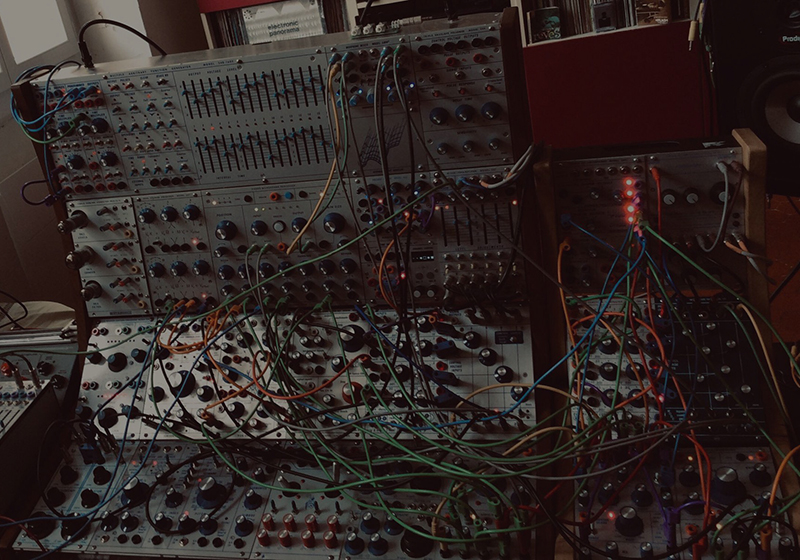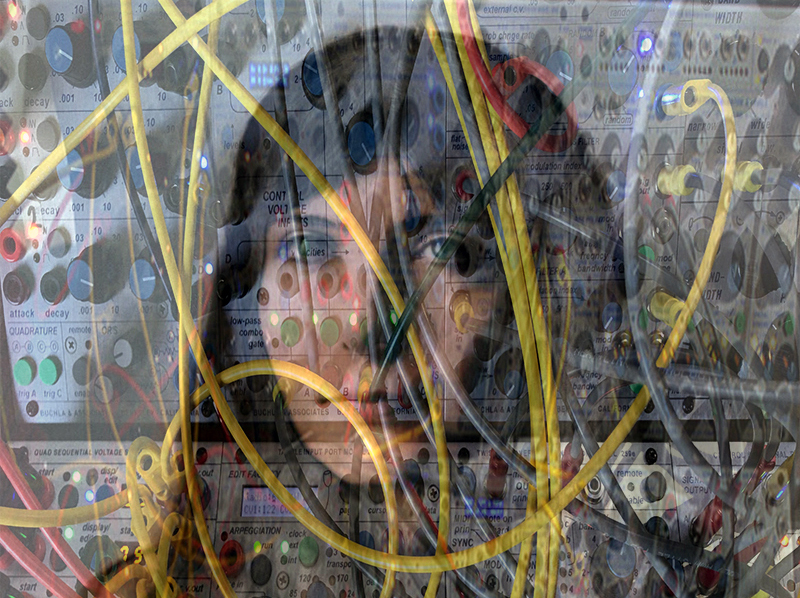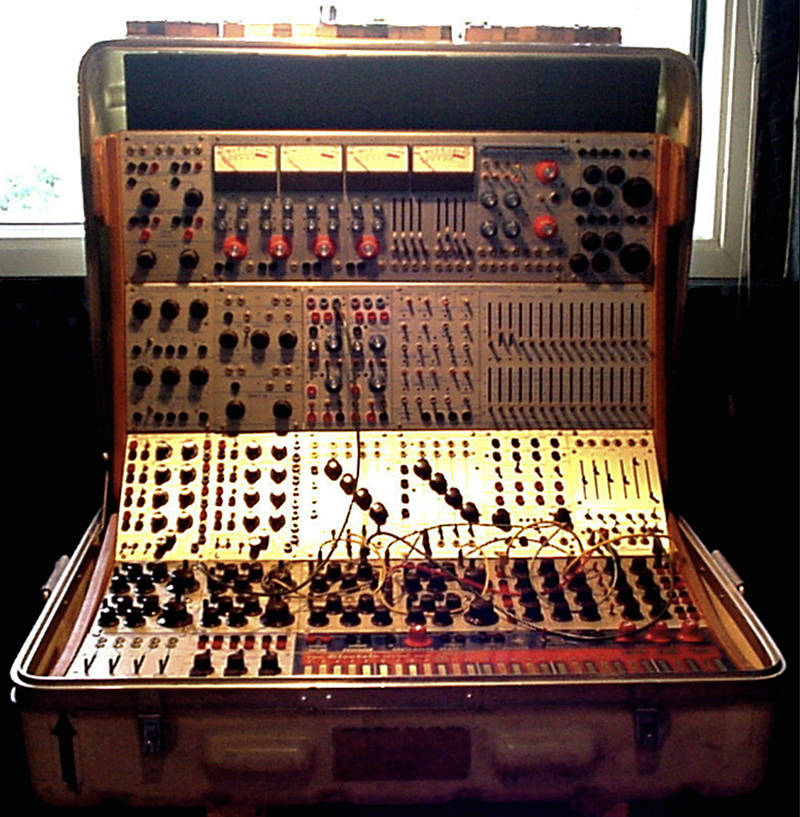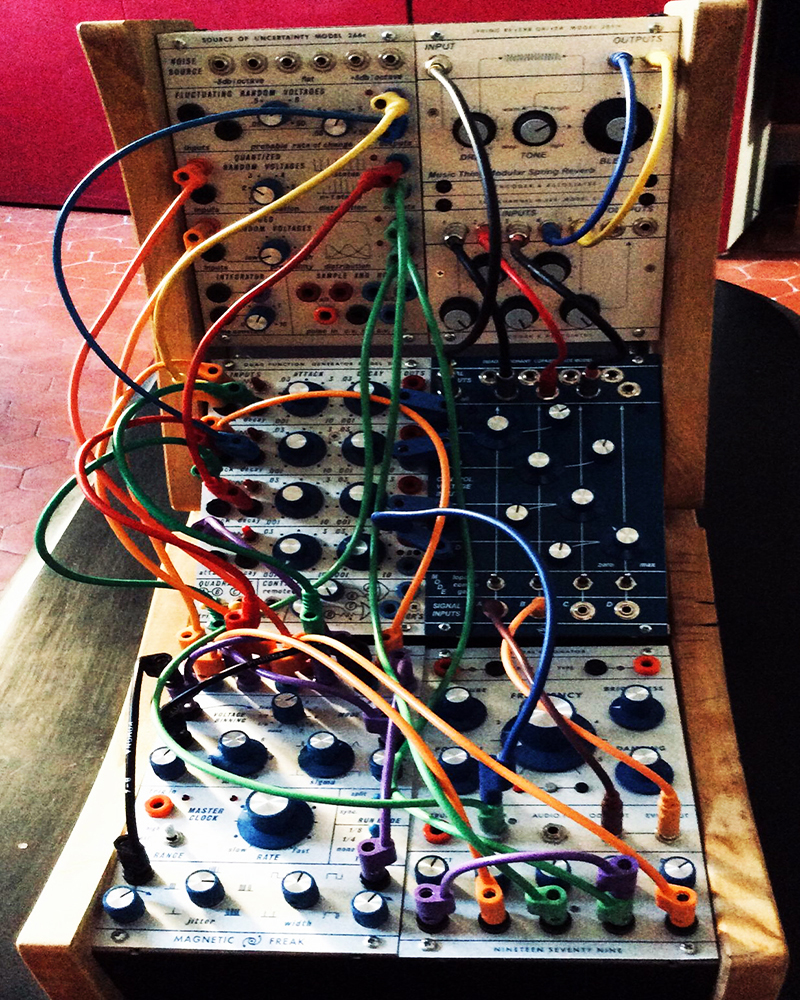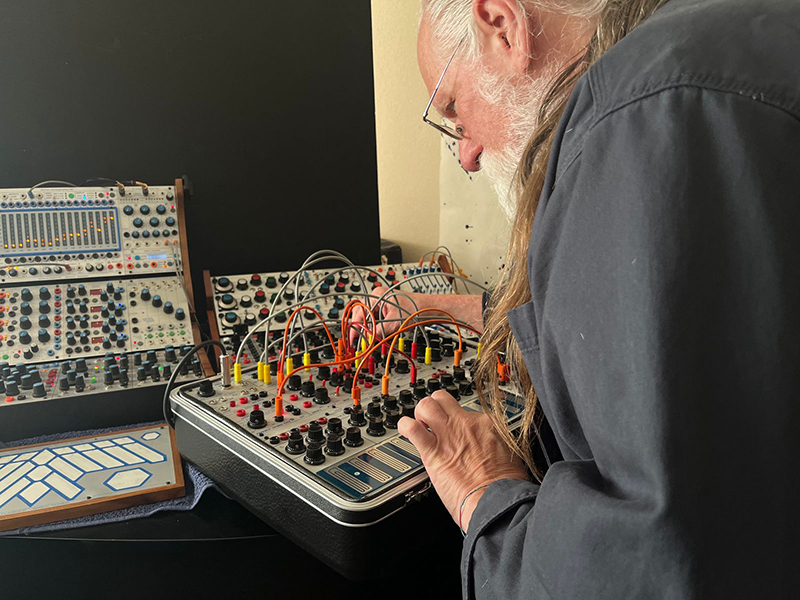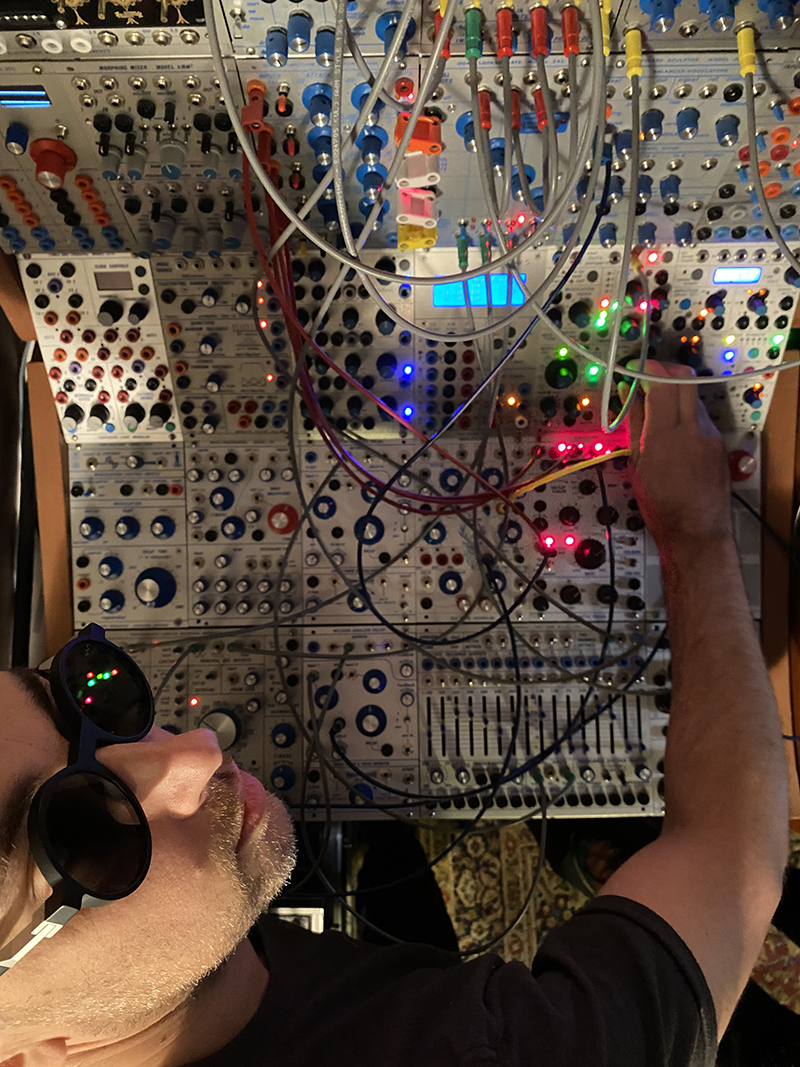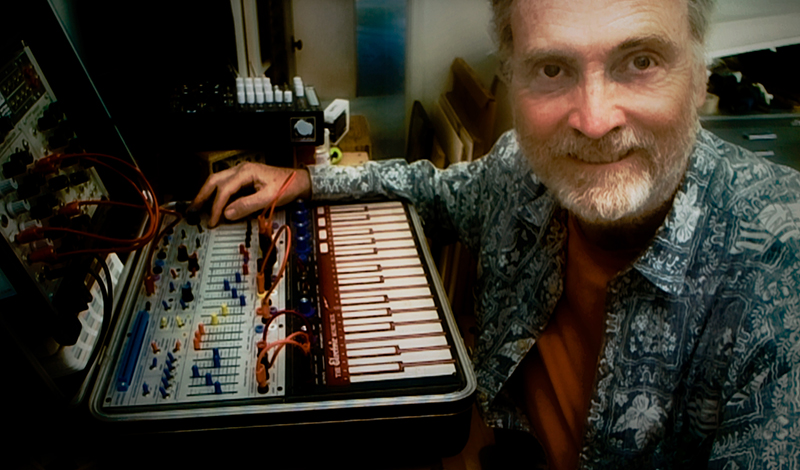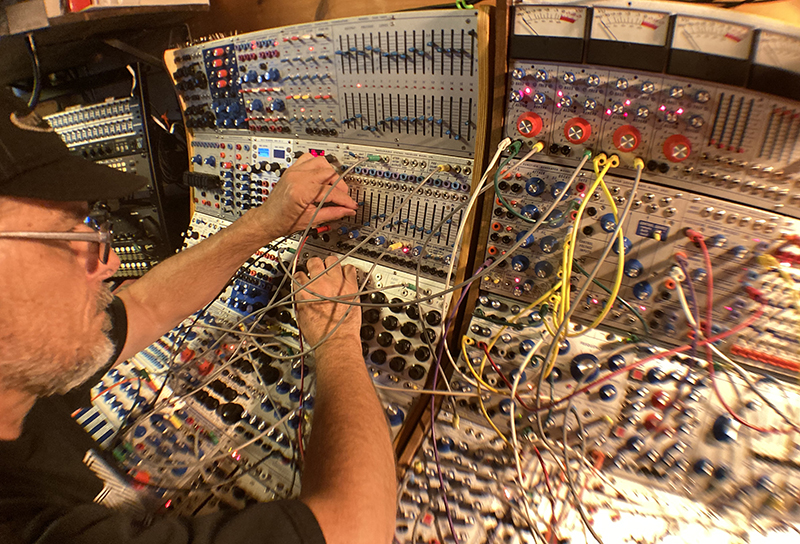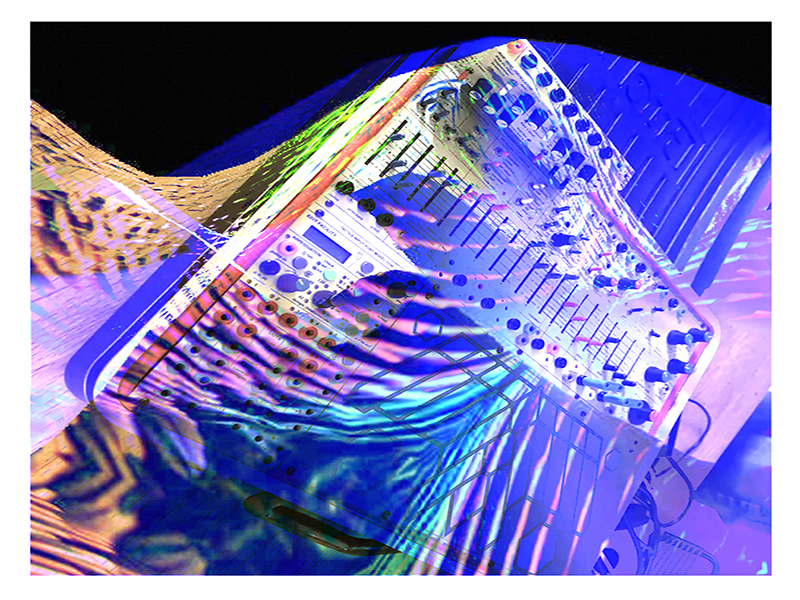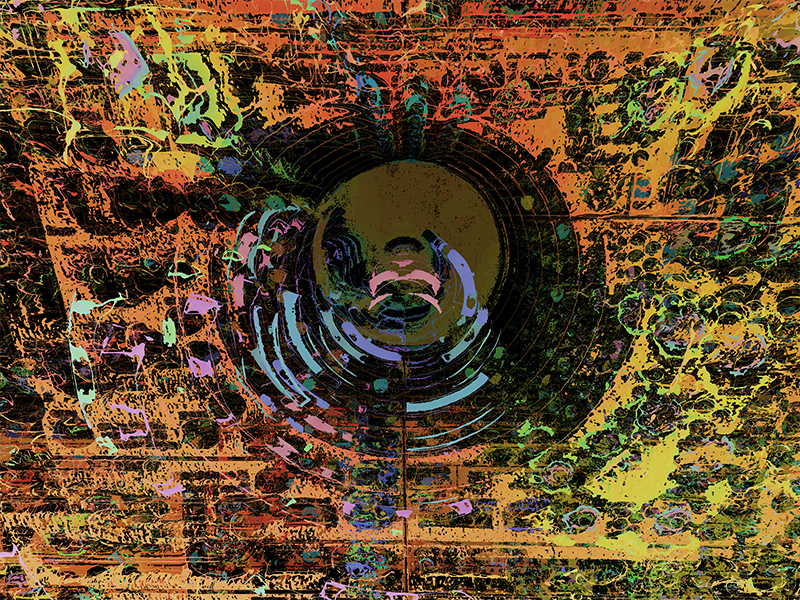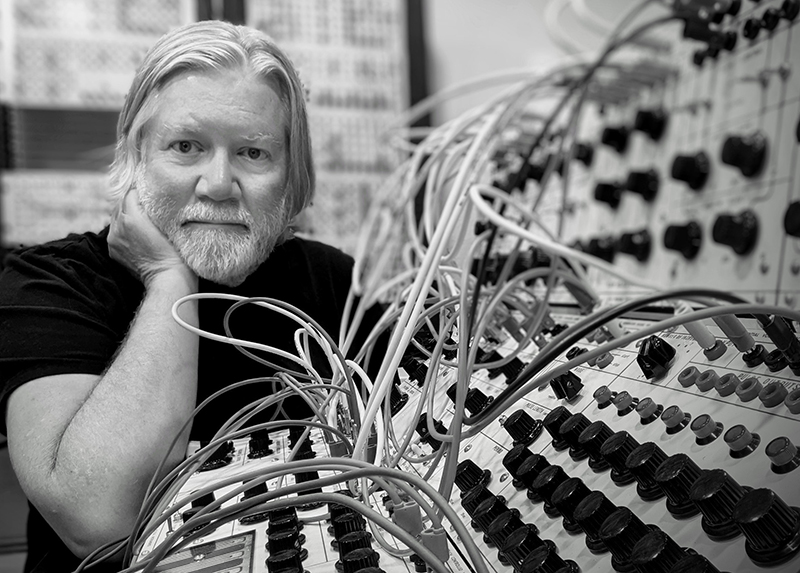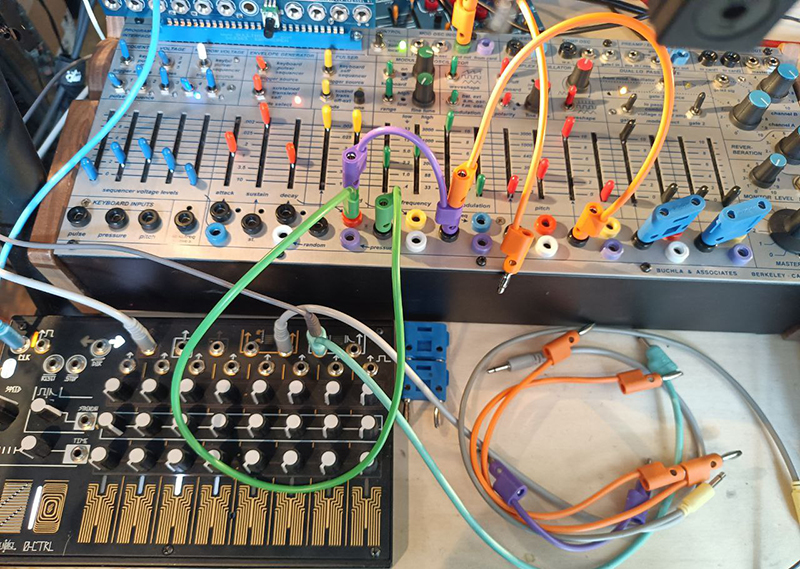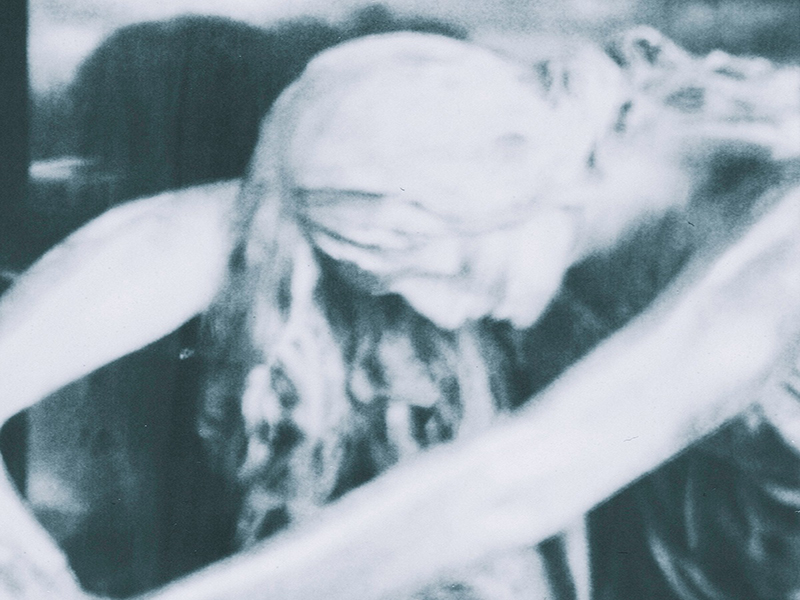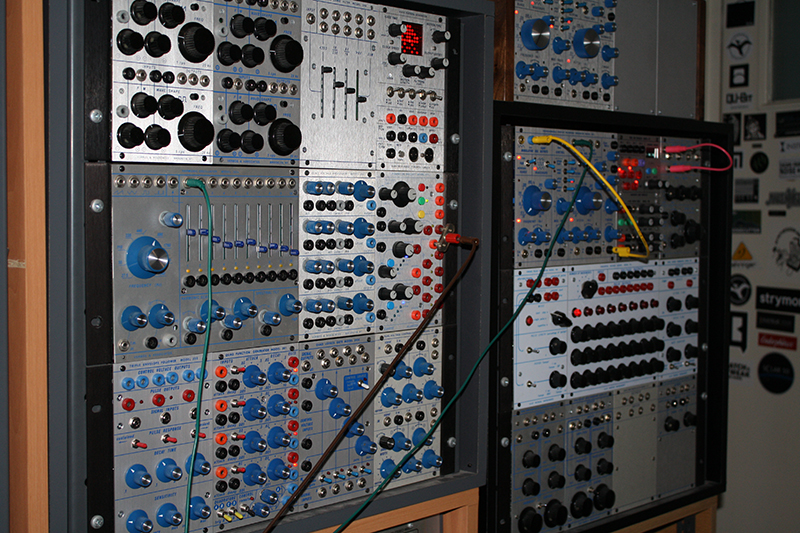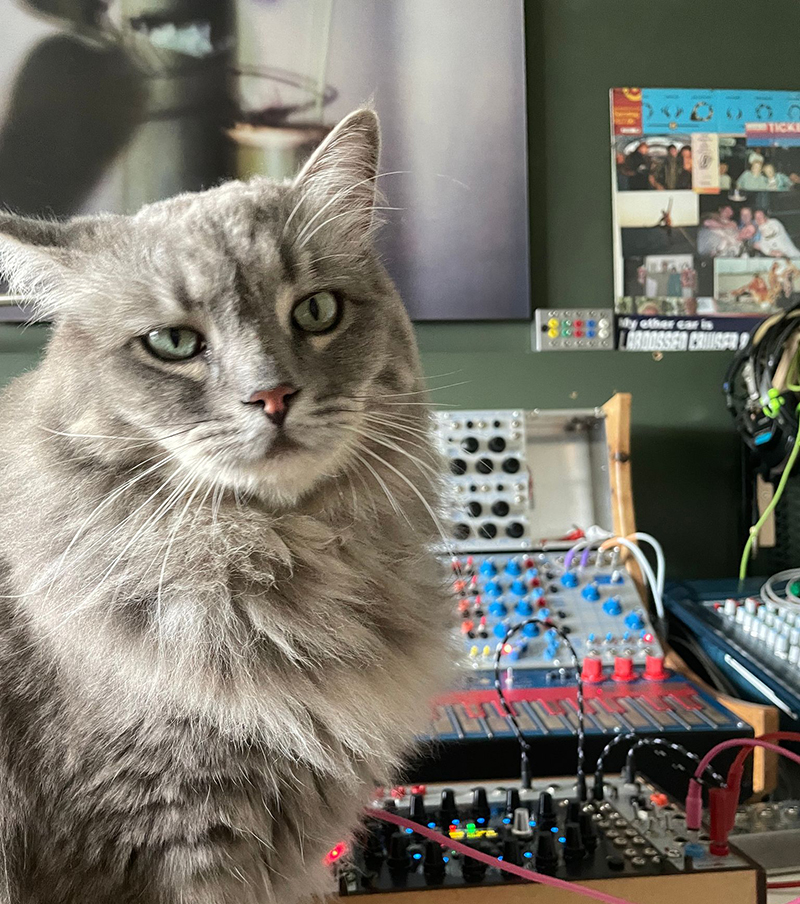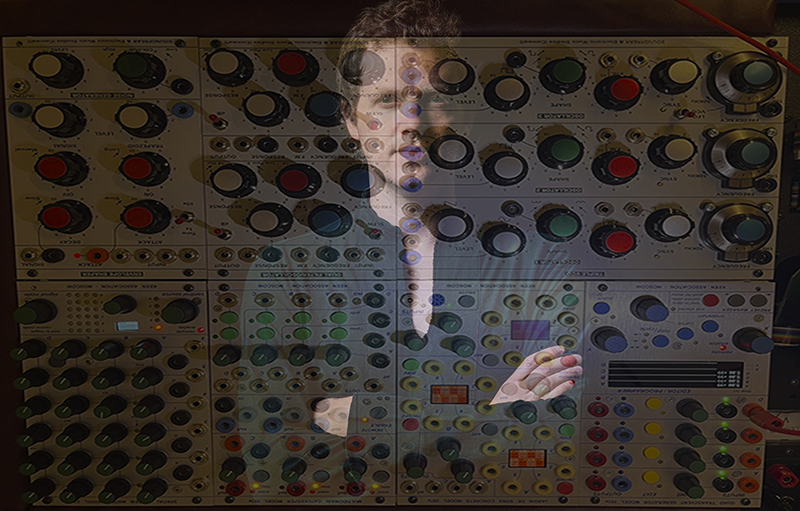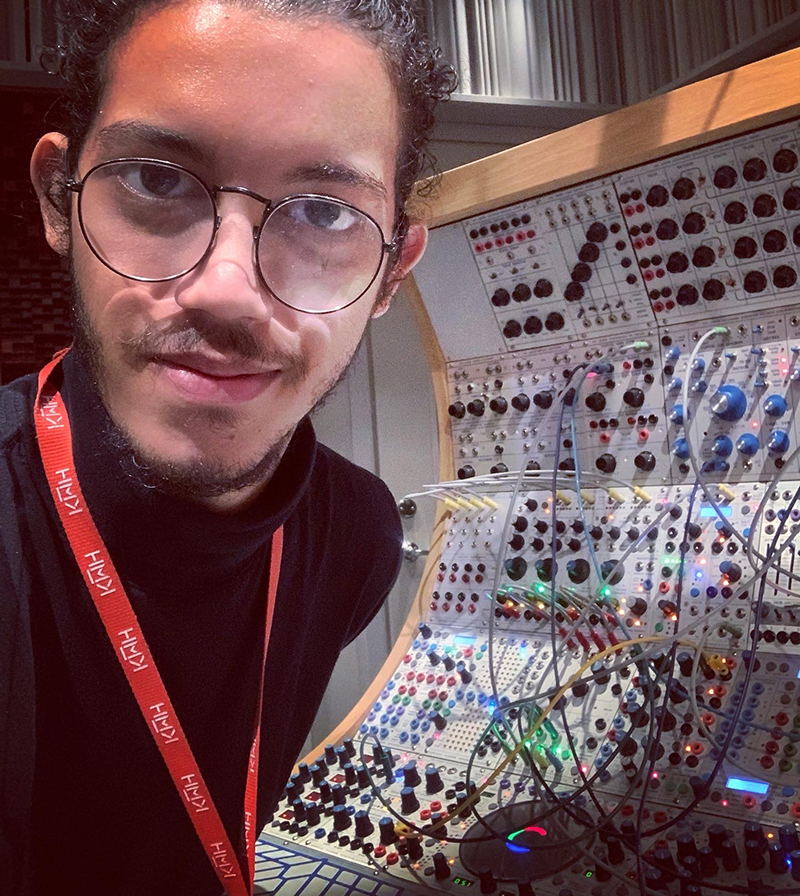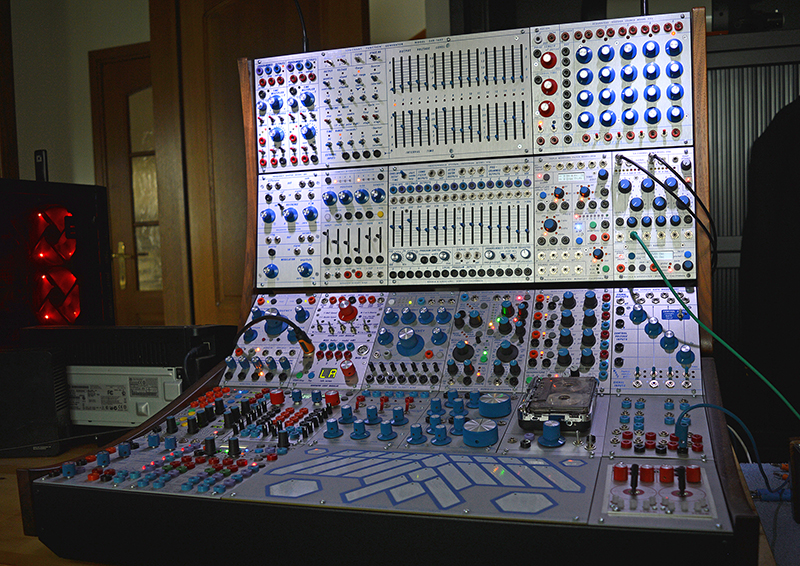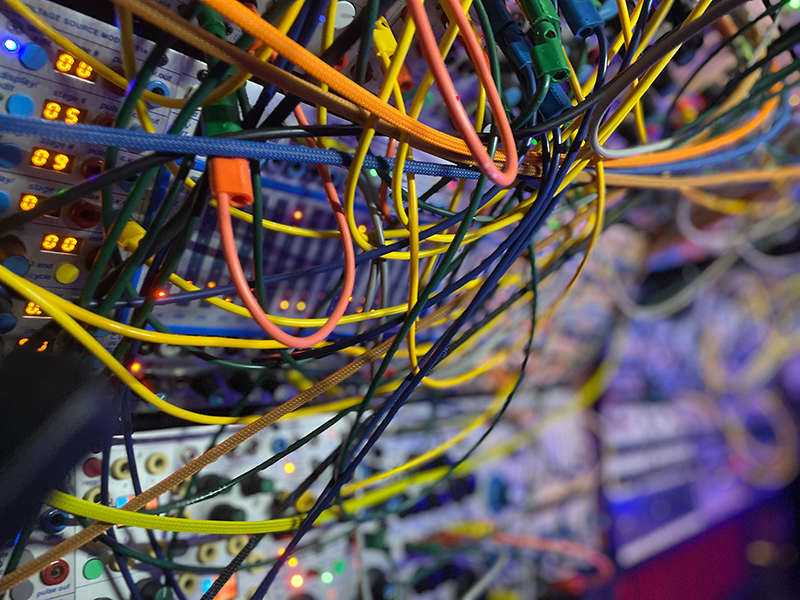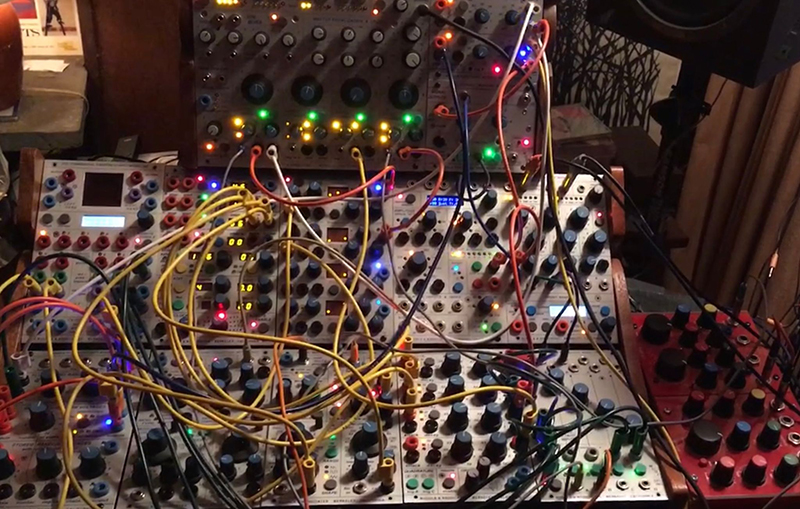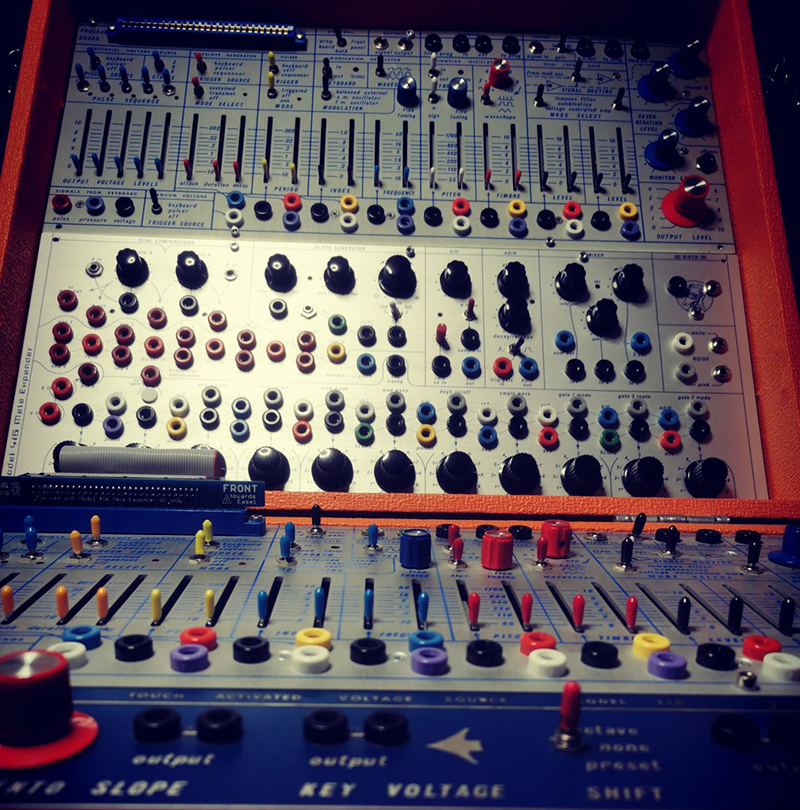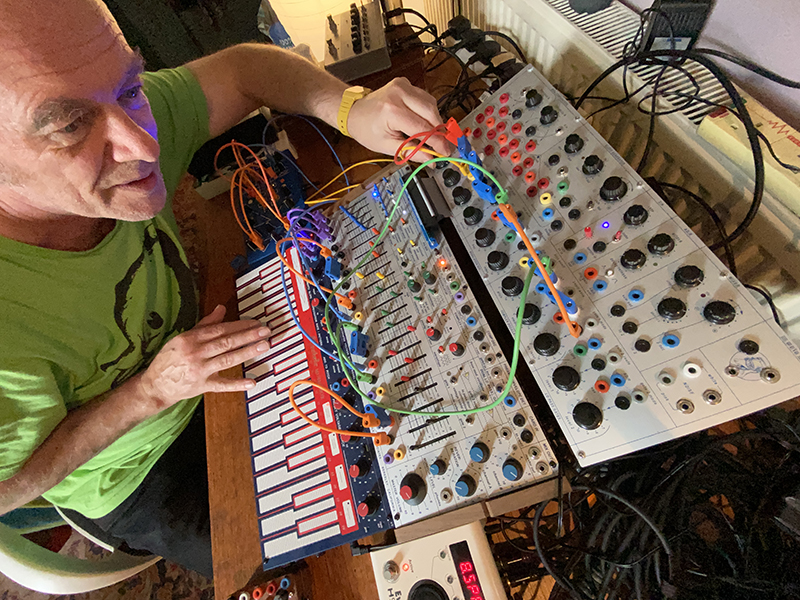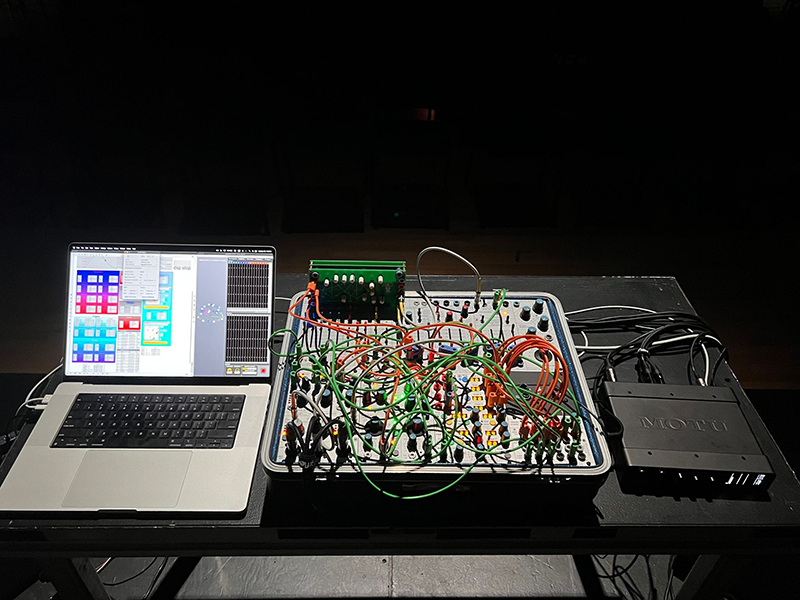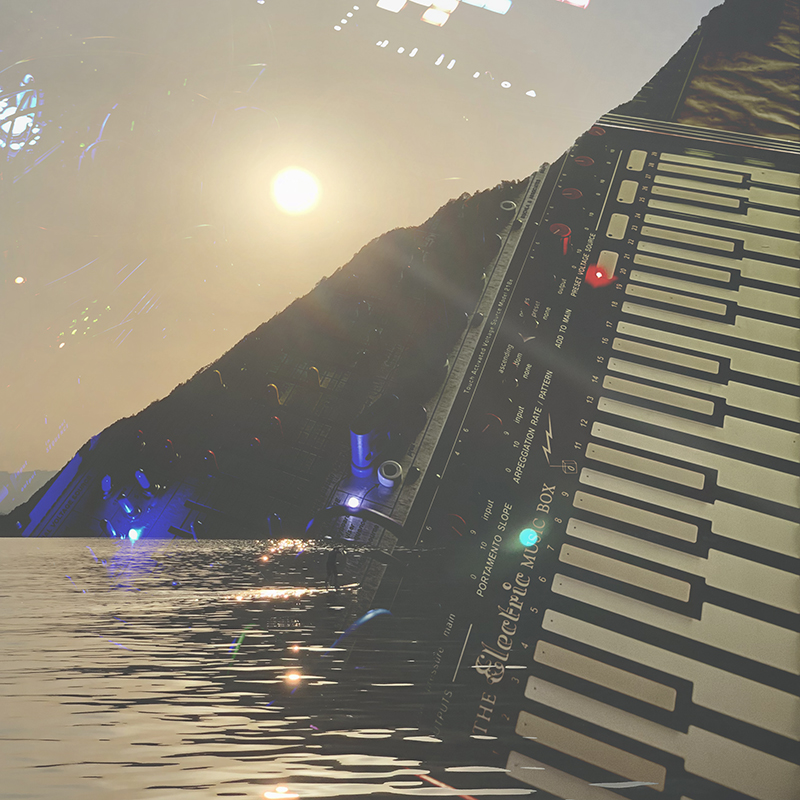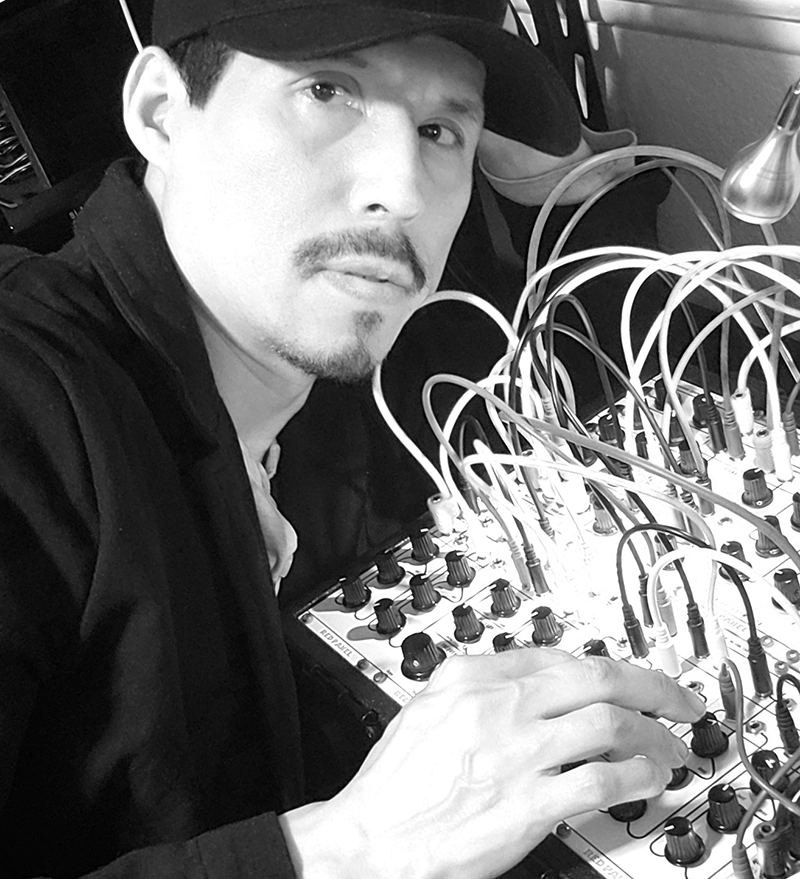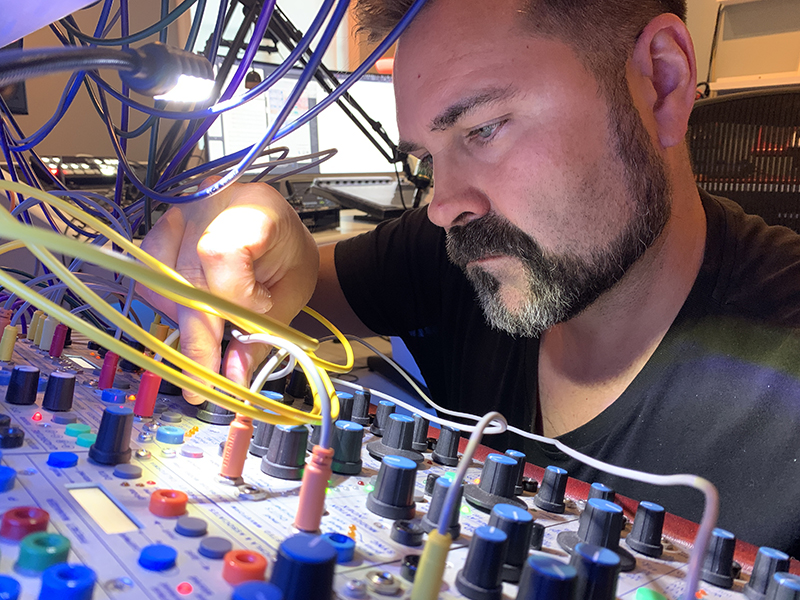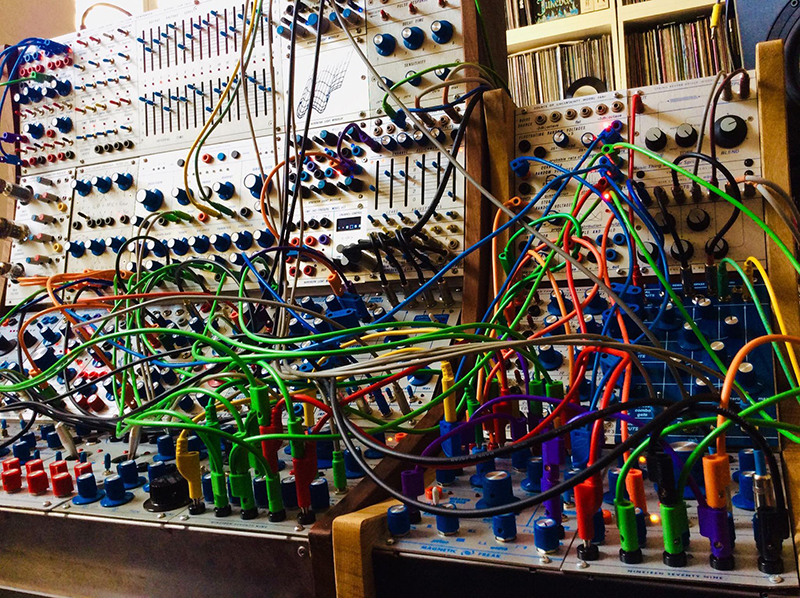
BUCHLA – often labelled as the Stradivarius of Synthesizers – is one of the most innovative « musical vessel » ever designed, whose extent of the sound spectrum does not seem to belong to this world and the logic lies apart from everything that may have existed before its creation.
The Buchla synthesizer is named after the electronics pioneer Donald “Don” Buchla, who manufactured his first modular synthesizer with the avant-garde musicians Ramon Sender and Morton Subotnick, the founders of the San Francisco Tape Music Centers (SFTMC). Both were looking for an engineer who could implement their ideas and requirements and found this person in Donald Buchla, with his extensive musical and technical expertise.
In 1963, they eventually managed to achieve together what they had been working toward for years: an analog, modular synthesizer, The Buchla Series 100. The Music Easel appeared in 1973 so we are celebrating both a “Diamond” (60 years) and jubilee (50 years) to close 2023.
3 years ago I started to gather some music from composers playing Buchla instruments and 2 volumes of BUCHLAÏSMS appeared!
https://modular-station.com/modulisme/session/21/
+
https://modular-station.com/modulisme/session/22/
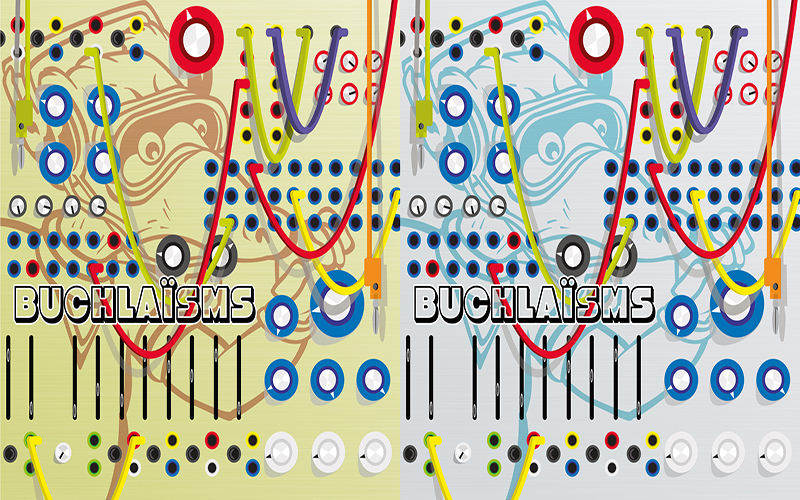
Those 2 volumes, offering about 7 hours of music were already a mammoth of a collection but I had a feeling that many players were missing. My purpose was to respect the historical side while showing today’s creation.
Thus the last few months have been very studious, spending a lot of time pulling strings, and now really proud to call our « Buchlaïsms » series complete.
SEVEN volumes, offering 183 exclusive works and 10 videos!!!
An unprecedented hommage. BON APPETITE!
01. Jessica Kert – An E under my fingertips (04:18)
Berlin based electronic musician and Techno producer, Jessica Kert loves diving into experimentation with her modular synthesizer.
Working in the famed Berlin synthesizer heaven Schneidersladen rest assured that she knows her ropes.
Peering her way through a dense forest of patch cables, feeling all these frequencies and with the love of the physicality, Jessica is playing her Buchla 200 with much dedication + she is constantly producing music and released her new album on the multidisciplinary arts collective Detroit Underground.I have been attracted to Buchla for almost 10 years now. Through my day job at the synthesizer heaven Schneidersladen I was suddenly surrounded by all these eurorack modular systems and ther builders, so I started to learn how to play these instruments and read basically everything I could find about the history of electronic instruments in general.
Of course Don Buchla came across and when I started to study his instruments during the Corona lockdown times I realized that a lot of nowadays electronic music instruments maker`s had been inspired by his work. As far as i am concerned I was always more attracted to the West-Coast philosophy and to me it felt like Don`s instruments were exactly what I needed.
When I heard his instruments in real for the first time I just thought- Damn! need to work on my gain- staging. The sound was so powerfull, massive and cristal clear.
To me the Buchla 200e system is simply mind blowing. Although I have a huge knowledge of modular Eurorack systems I stood in front of it and just thougt- well, have to start from the beginning.
Especially when it comes to the tremendous possibilities of the control interfaces. Basically I have constant explosions going in my brain, also when it comes to creativity. Not sure yet what it will bring to my artistical vision but already know for sure that it won`t be stagnation.
If I have to pick my favourite modules, it would be definitely the Buchla 223e. What I do love most about, it`s is physicality. You can control your Instrument on so many levels just with your fingertips. There is no need to think so much, you just go with the flow.
The System Interface 227e just opened a new door to me. The fact that you can hear the sound in Quad and the possibility to play with this is a very much exciting expirience. To feed in a signal from the outside world over the Mike Preamp is just awesome and very open minded.
Last but not least, the Buchla 210e Control Signal Router, which is such a helpful module to keep your Audio – and CV-control signals organized. Just by simple routing you can change your whole composition to something totally different.
02. Brett Naucke – Hallcinations IV (03:12)
Brett William Naucke is an American experimental composer and visual artist from Chicago, IL currently based in Asheville, NC.
Naucke’s sonic output has been primarily focused on marrying an ever-evolving practice of synthesis with conceptual narratives.
Beyond live performance, Naucke has provided the original scores for several films, sound design for interactive gaming, and presented many works for multi-channel audio and video installations + his most recent recordings have been released by a wide variety of acclaimed labels.
Additionally, Naucke ran the Catholic Tapes record label from 2007 to 2015, releasing 100 documents of American underground electronic music.“Hallucinations IV” is a rearranged soundtrack-esque section in EMS Hallucinations comprised of percussive padding, a meandering, ghostly melody, and textural electronics, immersing the listener in Naucke’s psychedelic sonic world. Part siren song, part minimal dance track, “Hallucinations IV” at once nods to classic underground electronic voyagers like Maggi Payne and Ruth White as well as more mainstream artists like Aphex Twin.
My fav Buchla module could be either the 296 or 208.
03. Meat Beat Manifesto – Buchla Waves (06:38)
Meat Beat Manifesto is an electronic music group formed by Jack Dangers (the only permanent member) and Jonny Stephens in 1987 in Swindon, United Kingdom. MBM has proven versatile over the years, experimenting with techno, breakbeat, industrial, dub and jazz fusion while touring the world and influencing the rise of the trip hop, big beat, and drum and bass genres.I’m not actually manually controlling the Buchla on this at all. I wanted it to randomly control itself in an improvised manner while filtering it through some external modules with various treatments and see where it goes.
I am drawn to the Buchla’s unique sound and its ability to produce a wide range of textures and timbres. The modular design allows you to create custom patches and explore new sonic possibilities.
I like the unpredictable idiosyncrasies which the synthesizer manages to do so effortlessly. The randomness appeals to me and sends you down roads less travelled. I will often record improvisations and then use those recordings as the basis for a composition. It really does sound unique.
To use it in the true sense of the word experimentation, and ultimately to enter uncharted territory. It allows me to create sounds and music that would not be possible with any other instrument. I use the ‘Source of Uncertainty’ module the most, I love the way that it can create unexpected and interesting effects. Obviously the oscillators are a prominent voice and with a bit of manipulation they can sound incredibly funky!
All synthesizers are different and like to combine all the ones I have along with the Buchla.
04. Phlippe Petit – Matter of Factly Krellish (06:38)
To follow up such funkyness from MBM I was looking for a bouncy groove, but also wanted to keep a moody atmosphere to ease the transition to the majestic Todd Barton composition that was to follow. Knowing that you’re never better served than by yourself, I decided to go straight to the point and to thank Todd, who – from a distance – taught me the basics of most of my modules, as well as the Buchla ethos, through his many video tutorials.
One of the first pieces of his that I heard was the “Krell” series, which was bound to attract me, since my first contact with electronic music was when I saw the masterpiece “Forbidden Planet” – back in 1973 – and heard its immense soundtrack by Luis and Bebe Barron. So I decided to go Krellish to pay tribute to the film and at the same time underline Todd’s talent and kindness in supporting our platform from the outset.As you know the character of a sound is controlled by three distinct properties: its pitch, its intensity and its timbre. When playing my Buchla I like to think not only in terms of the electrical signals that flow from one module to another, but also in terms of the sound energy that excites another module, where the energy is transformed into timbre. For example, the sound energy from the oscillator may excites the filter in the same way that a guitar string excites the body of the guitar. Have you ever made a wine glass sing? And noticed that with just the right speed, the sound gets louder and louder? Or pushed a child on a swing with just the right timing to give her speed? The physical phenomenon at play, in both cases, is resonance. When we say that a physical system has a resonance at a particular frequency, it means that bringing energy to the system at this specific frequency will result in large oscillations – but if energy is brought at a lower or higher frequency, the oscillations will disappear. It is as if the system is responding to vibrations transmitted at a specific frequency, but is dissipating vibrations sent at the other frequencies. Just like a band-pass filter! This phenomenon is present in strings, drums, or the air column in a flute. These systems do not have one single resonant frequency, but several, called modes.
So what happens when we pluck a string, strike a drum or blow in a tube for a short moment? The short burst of energy of the blow/impact contains many frequencies. Some of these fall outside of the modes, and are absorbed. Some of these excite the modes, producing a stable, pitched sound. What we hear truly is the interplay between the modes and the spectrum of the excitation which causes them to sound. The modes are like a mould, they represent a possibility of sound – it’s up to us to fill them with an excitation signal!
Modal synthesis artificially recreates this phenomenon. The modes of a vibrating structure are recreated with a bank of band-pass filters – one band-pass filter per mode. The frequency of the band-pass filters from my Digital Resonator determines the pitch (note) which will be heard and I chose to vary it playing my Source of Uncertainty so as to produce struck, plucked, blown, or bowed sounds… Only one voice resonating, minimal while strong, pure and straight to the point played with my baby Buchla (see the patch in the photo below).
05. Todd Barton – Buchla Bricolage (24:04)
Since 1979 Todd Barton has been exploring analog and computer-based music. He currently is a Consulting Artist for Buchla Electronic Musical Instruments.As the title, Buchla Bricolage, implies this large-scale composition is made up from “what’s at hand.” My process is that of curatorial composition. My daily practice is to explore and discover sounds and sonic gestures with my modular synths, in this case Buchla 200e, 200, Easel and Dodeca Module.
As sounds unfold and lead me onward I sometimes become excited to develop them as a composition or performance (audience of one, me). I’ll record these “performances” trying to make every gesture musical and unfold into the next. Of course, sometimes that works and sometimes it’s a learning process.
Buchla Bricolage is made up of many such “performances” that I discovered by revisiting folders of audio files. I listened to them with an ear to their cohesion and contrast culling them into an ever smaller selection of pieces/structures. Then, rather than composing with notes or sounds I composed, (put together) these larger structures with an eye and ear to the pace of transitions to create a journey through different timbral and textural environments. I hope you enjoy the ride.The first time I heard and approached a Buchla instrument was in 1976 with my friend, Doug Leedy’s Music Easel. I was blown away by the variety of sound possibilities and the kinesthetic sculpting of sound via the sliders, switches and knobs. To this day I am still discovering new sounds, sonic gestures and unfoldings.
The Buchla, in all its varieties, is for me an instrument to be played rather than programmed. The sonic palette that Don created feels and sounds organic and responds like an acoustic instrument. With so many ways of possible patching points the discoveries are limitless. It’s this continually opening sonic horizon that inspires me.
Chosing a favorite Buchla module is a hard question to answer. If I had to . . . it would be the 208, i.e. the center of the Easel.
06. Anthony Capelli – Theme Easel 5 (06:02)
Anthony Capelli is a composer, drummer, sound engineer and electronic tech.
Builder enthusiast of electronic musical instruments, he works within the Making Wave radio collective, released a portable mixing console, and he’s a part of Magnetic Freak, designing third parties Buchla compatible modules, such as the Gaussian or Benjolin.
He played drums and electronic in the French bands FAT32 & Chevignon and produces plays for Radio programs, theatres, short-movies.I had the opportunity to set up field-recordings for a radio project on urban planning issues around the Saclay site in France. I extracted and looped a sample and then synchronised the Buchla music easel to this loop. I recorded a theme and built up a bass line that gets fully completed throughout the second part of the piece. I took advantage of this track to create a gentle, disintegrating atmosphere.
Buchla instruments are very inspiring, the first time I was exposed to its sound was at EMS Stockholm. It was an archeological discovery as they own a vintage system from the 70s.
The Buchla system is a perfect “in between” instrument. Acoustic/Electronic, Analog/digital, sequencing/improvising, and none of them are sounding exactly the same, that is why i like to tweak the circuitry so that they sound close to what i like.
I’m crazy about delays and filters, one of my prefered Buchla module revision is the 296M for the vibes it adds to sound, 259 waveshaping and 292 are probably the combo to have the Buchla sound signature, 266 is genius to give life to the patch.
07. Benge – Autumnism (04:12)
Ben Edwards is an English musician and record producer based in England. Known professionally as Benge, over the years he has amassed a precious collection of electronic synthesisers, drum machines and studio equipment which is housed in his Memetune Studio. From there he writes and records his own music (over 40 solo albums) as well as his many collaborations over the years under the following names: Volume (with Richard Lee and Paul Elliott), Tennis (with Douglas Benford), Stendec (with Paul Merritt), Oblong (with Dave Nice and Sid Stronach), Wrangler (with Phil Winter of Tunng, and Stephen Mallinder), Fader (with Neil Arthur), Creep Show (with Wrangler and John Grant), as well as his continuing work with John Foxx & The Maths, Blancmange, and Stephen Mallinder (founding member of Cabaret Voltaire).
Recently he has been furthering his passion for vintage studio equipment, expanding into TV and Video production, culminating in his ongoing TV series The Memetune Programme, now in its second series.This is a multi-tracked piece made exclusively on the Buchla 100 synthesiser.
I approached the patching for this piece in a fairly ad-hock manner, and just enjoyed patching and playing with the system as I went along, with no particular goal other than exploring the Buchla’s warm sonic possibilities, on a very cold, wet, autumnal day.
The modules in the left-hand cabinets are all original vintage units made in the 1960s (apart from the middle 144 VCO which is my own clone made before the current slew of clones released since 2018).
The patch makes use of many oscillators going into the 191 Sharp Cutoff Filter, in bandpass mode, as well as other layers using the Frequency Shifter and Noise Sources. The Random module is a big part of the patches, as well as the Sequencers. But perhaps the most important modules in any patch on the 100 are the 156 CV Processors. This is because of the way Don designed the system, leaving off the CV processing from most modules. So for example, most functions on the modules have voltage control inputs, but no scaling knobs or mixers on them, so the 156 modules are used for this task.08. Bruce Bayard – Buchla Easel 2023-08-04 (07:55)
I love to follow the sound and to create this work I chose to use the same patch over two sessions. The first day, focusing on feedback and small gestures, and the next morning, combining that with big overlays of oscillators.When i first heard of Buchla synthesizers I was curious about the multifunctional modular system, and not being a musician, really attracted to the knob-turning, slider-tweaking, cable-connecting process to find sounds.
I use the Buchla Easel in my improvisational performances of projected video because of the ease and the versatility this one unit allows, all packed into a suitcase. It’s also great in the studio, sometimes in combination with Eurorack gear.
Anything is possible with Buchla: amazing washes of sound, beautiful timbre control and wave shaping, pulses, feedback, randomness. Such a rich and sensitive instrument.
Someday, I would love to have the 259 Twisted Waveform Generator, and the 266 Source of Uncertainty because “twisted” and “uncertainty.”
09. Illusion of Safety – Using Tone to Represent Mass and Volume (13:56)
Since 1983, Daniel Burke and his many conspirators under the Illusion Of Safety banner have over the course of 40+ full length releases traversed most every facet of the avant sound plane, from early industrial pop deconstruction to blindingly minimal sound art to densely surreal found-sound collage, each unique approach bending and reconstituting the expectations and possibilities of each realm, creating uneasy music that is dense and dystopian and yet also beautiful. Performing over 300 live concerts throughout Europe and the states included No Fun 2008, the Wroclaw Industrial Music Festival 2009, Sonic Circuits in 2010, and In collaboration with Shen Wei Dance Arts in 2011 at the Metropolitan Museum of Art in NYC. Outside of IOS Burke has collaborated with Jim O’Rourke, Jon Mueller, Randy Greif, Darin Gray, Z’EV, Cheer-Accident, Thomas Dimuzio, Kevin Drumm, Bill Horist, and others.This recent piece was done as an exploration of feedback. A bit more intentional than my usual playtime. I am getting a bit more directed and focused in my approaches to every kind of music these days. I also am getting more patient and appreciating long-form so I was able to let this piece breath a bit, slow down, & take its time.
I like to approach my Buchla like any other patchable/routing tool. I sit down and without much thought pick somewhere to begin and start patching, listening as I go and developing over time. The process is exploratory and fun. Eventually I land on a patch I like and usually live with it for some time. I know a lot of people like to pull the patch apart and start fresh each time but I prefer to get to know a particular patch as an instrument and see what it can do, after all the slightest changes to a knob make huge differences in the sound.
Overall the synth experience is more fun than the computer music experience I was having for a decade, now its time to go back further to real instruments and things that are less electronic.
10. Sig Valax – A Fistful of Eyelashes (04:13)
After attending the class of electroacoustic composition of Christine Groult at the Conservatory of Pantin (DEM) Sigolène Valax realizes electroacoustic and radio pieces, sound creations for live performance.
She is interested in wild lutheries and explores experimental improvised music with Vierge Noire, Elek Ember, Seuil Optique, Sauges, Mesce Basse, and Lucus Furrina.I’d like to retrace my steps back to the Buchla synthesizers and celebrate these magnificent machines that so vibrantly catalyse a form of freedom and creative power. So to follow in their footsteps I’d talk about the body, an organic body in which all the colours of the rainbow are hidden. First I discovered its skin, then little by little its structure and sensuality. I envision the Buchla synthesizers, particularly the Music Easel, as a naked body. I have the sensation that its flesh curves in the dampness of the electronic folds, and this nudity calls for very special attention. The instrument is at times shaggy, noisy, rumbling with fury and at other times fertile in harmonics, leaping from ritornellos to rhythmic or tribal sequences. It develops an unparalleled vocabulary with precision and tactility for us humans who caress it.
When I first heard the sounds of the Buchla, I felt as if I were in a state of grace. A clamour of summer ardour touched me, continued with fiery tones and struck my sensibilities right to the bone, along my spine and neck. The Buchla’s song sought my blood and I offered my veins. There was something bewitching, I was bitten by its spell.
For me, the Buchla system is a raging body that generates full-lipped waveforms and complex frequencies that vary in amplitude with powerful beats. It oscillates between fragility, throbbing sway and hardness. There’s also a martial aspect to learning to control all these tensions, resonances, filters, amplifiers and attenuators. The visceral dimension of the cables forces me to create a space of concentration in my skull to organise the multiple combinations. I juggle to find the tessitura I’m looking for, tapping, erasing or rivetting the aural behaviours and emphasising one sonority rather than another. There’s a relentless sunshine in my pupils as I trigger the different modules of the system.
It’s a beautiful desire to compose, a pleasure to weave the electronic material at my fingertips and it’s the synthesiser that teaches me to flutter. I appreciate the possibility of playing with random forms mixed with a rigour that is sometimes tough. The Music Easel doesn’t allow itself to be boxed into a cramped, formal design; it imposes itself through the uniqueness of its internal logic. Thanks to Don Buchla’s art, I feel an intoxicating form of perception that abolishes the antagonisms between mental control and playing with the hands.
My heart is won over by the Music Easel for its tactile and sensory dimensions. I let my fingertips guide me to control it. Barely touching the keyboard gives me physical sensations and creates a state of gestural and compositional readiness. It seems dedicated to creativity through precise instrumental gestures. The faders are extremely delicate, and the jumpers and banana plugs give another breath of fresh air to my playing. The whole nature of this modular instrument encourages me to continue my investigations to tune myself flexibly to its bewitching charms.
It’s a game of accordance with the warmth of the tones, the modulation of frequencies to give meaning and orchestrate the Control Voltage/Gate. This allows me to approach the modular system in a different way and in a way that is ever more sensitive to the characteristic sounds of the Buchla. By its very presence, the Music Easel provokes the beauty of an epidermal, tactile and sensual musical imagination.
Many thanks to Yan Proefrock for lending me his Music Easel K.
11. James Plotkin – I Remember When (05:54)
These days, Plotkin is well-known as a highly respected engineer and producer, and spends his week mastering and mixing releases for artists of all professional levels. While he has worked on major releases and GRAMMY-winning soundtracks, he still holds the art of DIY close to his heart, and welcomes opportunities to work with obscure artists and “difficult” recordings. It’s all part of the challenge that keeps him devoted to music and sound, and the constant evolution of how it interacts with and influences the human condition.I try to avoid prefabricated ideas when patching and let the piece develop on it’s own accord. Most patches start as a simple experiment centered around a single module, and wanting to explore the possibilities of that module. Inevitably, once I start to enjoy what I’m hearing, additional ideas are formed, and the patching continues until I’m satisfied with the results.
I listened to a lot of early experimental music in my young adulthood, and was particularly drawn to Subotnick’s “Silver Apples of the Moon.” Being a young musician meant that I was broke most of the time, and could barely afford the gear I needed to do what I was doing at the time. Once I could finally afford an Easel, I was instantly hooked – it became the gateway drug to a full 30u system. To my ears, Buchla is a truly unique monster – both vintage/classic and modern in sound, instantly recognizable in most cases as it has it’s own sonic character, and the designs makes patching a lot more fun than with most other systems.
I don’t have a method of working that’s set in stone. Typically, I won’t even start patching with the idea of realizing a full piece – it starts with the desire to try and get “more” from a specific module, and inevitably develops outward. For whatever reason, I try to keep my Buchla patches within the system – I will occasionally introduce non-Buchla modules into a patch for tasks such as psychoacoustic processing, or drum machines for beats, but for the most part (and I’m not exactly sure why this applies to my Buchla system specifically), I like to keep it homogenous when working with Buchla gear.
The Source of Uncertainty will always be my favorite module, with the 250e DAFG as the runner-up. I’m devoted to controllable random generators, and the SoU gives patches life and sometimes unexpected evolution. A stale patch can become an electric organism when the SoU is introduced. At one point I had 3 of them in my system, but admittedly, it was overkill.
12. James Collins – De Profundis Clamavi (05:10)
James Collins has been fascinated by electronic music since the late 1960s and he creates electronic music for his own enjoyment and perhaps others’ who stumble across his work.This piece was performed in one take on my La67 Buchla 100 clone system. I’ve found the 100 series is a very hands-on performance instrument and can be quite expressive. I wanted to create a simple piece that conveyed emotion and allowed the unique sound of the 100 to take center stage.The touchplates interplay with a slow ostinato from the sequencer. There is a very wide frequency range in the piece so it is best heard with good headphones or speakers.
I first encountered the Buchla synthesizer in the mid 1970s when I stumbled across Morton Subotnick’s “Silver Apples of the Moon” and “The Wild Bull”. I was smitten by the gorgeous sounds. So different from the Moog sounds that were then everywhere. The first time I heard one live was a few years later when I attended a concert by Subotnick.
I like using the Buchla 100 as a live performance instrument because it lacks many control features which would appear later on Buchla instruments. It requires a much more hands-on playing style that I find refreshing. It also lends itself to music that is less “programmed” or “automated”. It’s such a nice change of pace from my Serge and leads me to very different musical results.
Why the Buchla 100? The 158 Dual Sine – Sawtooth Generator oscillator! This module is alive. My system has two of them and they always amaze me with their FM’d tones. Everything else is just (!) to extract those sounds from the 158. Especially useful in that regard are: the 140 Timing Pulse Generator with it’s very playable pulse length control and alternating outputs; the 191 Sharp Cutoff Filter which is really unique; and the 116 Touch Controlled Voltage Source touchplate for hands-on performance. But I’d be happy with a single 158!
13. Wang Inc. – Some Light in Dark Years (07:33)
Bartolomeo Sailer started to make music at the beginning of the 90s and ever since the music of music has managed to bring some rhythmic playfulness to a good dose of experimentations. Pleasure for body and mind !This track is a mixture of happy moments that rise from the dark pads. I used my Make noise 0-control to tune each stem and then created with his functions a variety of tonal melodies and rhythms. I did a studio composition overlying different tracks that are played live, since I only have one Buchla Module: the 208C.
The first time I heard a Buchla synth was a few years ago at the Terraferma festival where I heard Charles Cohen play his Easel. For me it was a mesmerizing experience and I wanted so badly an Easel. But at that time I was poor and could only afford the virtual emulation by Arturia. A few years later I became and orphan and had the money to partecipate to the 208C kick starter. It took some time to have the synth at my studio because of Covid and components shortage.
But now it’s been here for some time and I have great fun whit this incredible instrument.
Mostly I use the 208C as a percussive system, I like that you can do very complex rhythms and create a wide variety of sounds. I think that a 2k euro oscillator brings a new dimension to my setup because of his intensity and grit. And really love the sound of the LPG the 208c uses. More difficult for me is to use the 208C as a melodic instrument since it is sold whit out a keyboard and is more intended as an atonal instrument.
14. Sova Stroj – Saltatio (12:57)
Sova Stroj is the nom de plume of Luxembourg-based producer Michel Flammant.The basics of this track have been recorded live in one go with an original Buchla 200 located at EMS Stockholm. The initial idea of that session was to slowly animate and transform a multi-oscillator drone into a more rhythmic piece without breaking the initial flow, by minimally shifting interconnected parameters in the patch. So to say, to make the sounds and timbres dance around each other, hence the name of the track. Later on I have done a bit of editing, arranging and eq-ing.
For me the Buchla has a very different feel from other modular synths. This is mainly due to the interface which is very intuitive and that the system feels like a coherent instrument rather than just a collection of modules. Nothing else compares to the workflow of a Buchla. And then of course the sound is quite different from what you usually hear in synth music. It has this very organic and acoustic feeling to it. Messing randomly around with a Buchla very often ends up in something enjoyable to listen to which is not necessarily the case with other modular.
A Buchla is an endless labyrinth of enjoyable sounds.
I have both worked with 200 and 200e systems and I like both for different reasons. While the 200 has a very raw and direct sound as well as a very simple interface, the 200e is incredibly deep and complex with a different sound. Both instruments have their place side to side as they cover different grounds and needs. The biggest downside though of the 200e is the lack of development by the Buchla company. A general overhaul that would get rid of the bugs and flaws would definitely make it the cutting edge, perfect modular instrument as it was intended by its creator 20 years ago.
When I work with the Buchlas I mostly do long improvisations and explorations. I try out things, ideas or just let the instrument guide me. So I am recording hours and hours of material which – days, weeks, months or years later – turn into tracks that are being released. I rarely compose finished tracks on the Buchlas but rather use them as a source of inspiration and raw input. So my Buchla output is mostly coming from digging in my audio archives and polishing the pearls that I find there.
It is hard to say which are my favourite modules as they mostly come to life in combination with each other. That being said, I love the different control surfaces and all the complex oscillators. With just those oscillators you can do so much, it is incredible.
15. Parallel worlds (Bakis sirros) – Tilt (04:50)
Greek synthesist Bakis Sirros offers some organic, analogue modular excursions for lovers of Electronica, Dark Techno, Downtempo & IDM…I like the vast synthesis capabilities that the Buchla modular allows + of course the high quality of its sound that is really unique!
That is why i started building a Buchla modular system… First i built a 200e system and later added 200 series clone modules and 100 series modules…
I record loops, rhythmic loops and soundscapes from the oscillators, to Wavelab and then import these audio files to Ableton Live. There I create the final arrangements. When i want to create a melody with an old 100 series buchla oscillator, I record individual pitches (individual notes) and then copy/paste these individual notes into a melody in Ableton Live…
The 200 series 259 oscillators and the Verbos 262v Harmonic Oscillator sound awesome! I like a lot the Eardrill Pendulum/Ratchet module and from the 200e series, my favorite would be the 259e oscillator, again, because it sounds unique…
16. Sendepause (Bart Wolff) – Mon chat le roi mon roi le chat (10:12)
Bart Wolff comes from The Netherlands where he makes happy accidental and always improvised music. Anything can happen, sometimes with a beat and sometimes not, depending on his mood. Bart started playing records a long time ago at the Zuid-As, Paradiso and Kriterion.About the compositions: There is no real story behind them. I’m not a trained musician. If I have an idea in my head, I have a real struggle to translate it into music. It’s also very frustrating to accept that I do not have the abillity to translate these ideas that I have into music.
But: I have found a way to more or less make things that sometimes do come close to what I hear in my head. Not always but it does happen.
These two compositions had a bit of a different approach. The Music Easel piece was done during a holiday where I “found” the melody. The Buchla 200 piece was a bit of a trial and error and was actually the second piece that I made for this compilation because in the end, I wasn’t really satisfied with the first Buchla 200 piece I made.
I fell in love with Buchla after I had built my 208 and had it calibrated properly. It wasn’t love at first sight because it really needed some work sound wise. I then started building the 200 modules that I have. I’m actually only really fan of the old 200 series modules. That has also to do with price, build quality etc. I’m not a fan of the 200e series, too expensive, too many options, too much hassle. The simplicity of the original 200 series is fantastic.
I’m not your typical Buchla musician I think. I’m not very experimental and I might use it in the most basic ways actually. I just love the sound and how fluent is the system, so pleasant to play with.
I think my favorite would the Music Easel, because it such a self-contained fantastic instrument.
17. Emanuele Nanni – Persone Sconosciute (05:38)
Enanni lives in Parma and his music belong to a rational approach that coexist with a paradigmatic essence, favoring the intentional accident of a classical culture immersed in an uncertain and dark modern framework.The track “Persone Sconosciute” is an improvisation created using samples of voices of unknown origin. Repetitive sounds and dissonant pulses contributed to the atmosphere of the track in which acoustic, ambient and electronic elements can be found.
The modular instruments in Buchla format have been occupying all my musical attention for two years now.
The most fascinating aspect of these instruments is the multitude of expressive registers they can have. Despite their electronic nature which in fact brings them closer to being perceived as “machines”, these instruments are extraordinarily expressive and it is in their ability to interact and be programmed by the musician that they owe this characteristic.
I am interested in the nature of sound, the vibrations and frequencies that can be part of both the natural and electronic world without a precise boundary. Buchla in this sense is the perfect instrument: its sound is woody, percussive, complex, from deep bass to the most sibilant frequencies.
In my modular system modules from different companies coexist. For the modulations, the controllers and for the paradigm they are carrying forward, Keen Association modules are my favorites. For their sound, for their organicity and for their endless source of inspiration, the SoundFreak modules are unrivaled.
18. Matheus Souza – Sad serenade for nostalgic sound waves (15:31)
Matheus Souza (b. 1997) is a composer and performer from Rio (Brazil). Currently, he is pursuing a Master degree in CoPeCo at CNSMD de Lyon and his catalogue of compositions includes not only electroacoustic but also instrumental pieces.
As an electronic musician, Matheus Souza focus in playing his Buchla Easel Command having aggregated to it New Technologies for live processing via Max MSP patches programmed by himself.Since last year, I went deeper on my Brazilian indigenous roots and I felt myself instigated to bring those references to my music. I realized I was already doing it – but in a intuitive way – after reading a Mark Fell’s paper in which one of the topics is his analysis and perspectives of Ten Houten’s time-consciousness structures. This piece emerged from the investigation over the aforementioned topic that is being conducted during my masters degree studies in Contemporary Performance and Composition at CNSMD de Lyon, having artistic research in music as methodology.
I felt attracted to Buchla instruments because it allows controlling with great flexibility many parameters of the sound, and moreover offers the possibility of creating rich and complex sound atmospheres. The day I first listened to a Buchla system in real I was an exchange student in the Royal College of Music in Stockholm and I felt happy and touched because I realized the privilege of being able to have a Buchla system available every day so I could practice and compose on it, then I got impressed by the qualities of a simple triangle wave generated by the PROGRAMMABLE COMPLEX WAVEFORM GENERATOR MODEL 259 simply patched to the QUAD DYNAMICS MANAGER MODEL 292e and then to the output module from the Royal College of Music in Stockholm, the “SIGNAL TRUNK LINES” being output via Genelec loudspeakers.
I hardly ever use controllers and the way I like to play the Buchla is concentrating on the knobs and faders and taking it as a compositional and performance electronic tool that allows me to express my ideas in an Experimental Electroacoustic way.
I’d favor the Complex Waveform Generator Model 261e which allows the composer-performer to produce such a rich variety of sounds with many colours and already create movement if in combination for example with the 266e Source of Uncertainty, which is a fantastic module that allows a infinitude of possibilities with randomized voltages for controlling whatever the composer-performer wish, and it still has the noise outputs beautifully used by Suzanne Ciani also for creating the “Ocean”.
I would go ahead with the Spectral Processor Model 296e because of the powerful possibilities of shaping the sound, emphasizing specifics harmonics and all the programs possibilities and combinations, and specially Morph cv input that depending on the Spectrum XFER and Display modes and from where it receives the CV can create rich modulations on the sound spectrum. The Quad Voltage Controlled Envelope Generator Model 284 by its functionality and possibility for having more cv outputs to voltage control in a cyclical-automative way other modules, changing pitch, modulation, opening and closing signal outputs, or the spatialization…; I also like the Quad Dynamics Manager Model 295e, specially because of the low pass gate that – in my point of view – creates a more organic and natural sound, and also it can assist in the creation of several layers in an elegant way and also emphasizing the sense of distance of a sound; and by the end the System Interface Model 227e because of the possibility of composing and performing in a quadraphonic sound system and being able to control the direction of the sound and the intensity of the movement via CV.
19. Luc Debeck – Bugs on Enceladus (07:15)
At the end of the 70’s, Luc Debeck got exposed to the radio programme “Music from the cosmos” discovering music by Klaus Schulze, Tangerine Dream, or Brian Eno. Later on he discovered the so-called West Coast style synthesis and started to build his Buchla system.My intention was to make a musical track of Enceladus, Saturn’s sixth largest moon. This Moon of Saturn could be perfect host for living creatures and other specimen never found before.
The story of the track “Bugs on Enecaladus” is about astronauts visiting Enceladus. What they find are bugs, alien insects and other living creatures. They look dangerous but are intelligent. They make special sounds and are communicating with the astronauts. Though slowly more and more creatures keep coming from everywhere and become a threat for the astronauts.
The astronauts take an insects in a special capsule for research and leave the moon Enceladus as quickly as possible.Above all Buchla sounds exotic for me, offering unique timbres and beautiful sounds. Totally different from the East coast synth like Moog synths I was used to. I own a Buchla 200 system and Buchla Easel and I’m also attracted by their design, color scheme and how the modules are presented.
Each color has a structured meaning of inputs and outputs. Very clear to understand and straight forward. Also attracted by Rogan knobs but the most important remains that each module can be a little system on its own.
What I also like about Buchla is that only a limited amount of modules exist, not 1000 modules like the Eurorack thing.
Thanx to Banana cables I can stack several CV outputs without losing voltages. Buchla is my high priority instrument.
The first time I heard the Buchla, I said “wauw….what is this…”?! I loved the plucky but also the more experimental music made with it. The way it behaves with lots of random functions.
I played some Eurorack in the past but Buchla works on a higher level. So the first time I heard the Buchla I was overwhelmed with beautiful sonorities.
I always choose one of my oscillators to start with, straight to the mixer. When I have an experimental idea I think already to the next module which can be interesting to complete my piece.
If it is more experimental I try different modulations step by step ’till I reach my goal. When I’m not happy, I un-patch everything. Modulating the sounds is very important for me. Not too simplistic, but neither not too complex.
I like to have control of my system and know what I’m doing. It’s like reading a book without thinking of the meanings of the words and letters. The more you work with the system, the better you become acquainted with the instrument though even making a mistake in patching can result in a nice sound. It is very important for me not to follow the sounds of boring and repetitive sequences. Variations is crucial.
I have several favorite Buchla modules, though my #1 favorite is the Model 248, Multiple Arbitrary Function Generator (MARF). A very complex module with Programmable voltage source and processor and so much more, you can create envelopes, sequences, LFO’s, programmable stages with interval times etc… It’s an instrument on it’s own. A MUST HAVE to complete a descent Buchla 200 system.
20. Thomas Dimuzio – Foldings XIV: Sidles (2:09)
Thomas Dimuzio is a musician, composer, improviser, sound designer, mastering engineer, and music technologist residing in San Francisco, CA. His music is like a sonic excursion that transports the listener into other worldly aural realms.
His recordings have been released internationally by ReR Megacorp, Asphodel, RRRecords, No Fun Productions, Sonoris, Drone Records, Odd Size, Seeland, Monotype Records and other independent labels. Among his collaborators are Chris Cutler, Dan Burke, Alan Courtis, Nick Didkovsky, Fred Frith, David Lee Myers, ISIS, Matmos, Wobbly and Negativland.I have an ongoing project called Sculpting Electric where I’ll spend days building complex patches between Buchla 200e and 200 systems with the intention to facilitate live in-studio compositions. This particular Sculpting Electric patch is themed and titled “Foldings” and seventeen variations were recorded; four of which were hand-picked for Modulisme. Clocks, pulses, and subdivisions form the heartbeat of FOLDINGS. A central clock seamlessly integrates various systems, delivering pulses to sequencers, randomizers, clock dividers, envelopes, and effects. Inspired by Suzanne Ciani’s pioneering technique of vertical sequencing, FOLDINGS crafts infinite variations of basslines and motifs with minimal programming. Through touch plates and voltage processors, multiple systems are harmoniously united, functioning as a singular instrument—powerful in its might, yet refined in its guidance. A subtle adjustment can lead to profound transformations. Each track in FOLDINGS showcases variations by tweaking parameter values within the same patch, all captured live without any overdubbing. Originally recorded in rich dual quadraphonic sound, these tracks have been distilled into stereo versions.Recorded on Buchla 200e and 200 systems with modules from Buchla, Eardrill, Keen Association, Northernlights Modular, Studio.h, Vedicscapes, Metasonix, Sputnik, Verbos, Peake, and Bocock.
As a sampling artist it took a few decades for me to come around to modular synthesis and Buchla systems. It wasn’t a particular piece or sound that attracted me as much as looking for inspiration beyond what I’d done with sampling. A Buchla wasn’t really possible to audition in person, but after a few calls to Buchla headquarters, where Don Buchla actually answered the phone, I took a leap of faith and dove head first into what I’ve called my ‘mod-life crisis’. Around then my friend Chris Muir of Eardrill graciously demo’d his system for me, but I had already bit the bullet and sent the down payment to Don. Buchla’s forward thinking modules, elegant design, and larger form-factor also beckoned. After diving in I quickly realized how I was essentially sculpting with electricity. This may seem obvious, but after working for so long with MIDI-based instruments and 128 steps of granularity, I found this lightspeed precision a treasure to behold.
I can’t think of any other musical environment harnessing raw electricity better than Buchla. The consistency of design between modules is also something that I’ve come to appreciate: the segregation of CV and audio signals; the CV color coding, the audio inputs on the bottom and outputs on the top, and uniform gain-staging all contribute to a more seamless musical workflow.
This system always pushes forward.
My Skylab is a performance system that’s evolved into a well-integrated selection of modules interconnected by a fixed patch so that the system is immediately playable and as versatile as a musical instrument. The case also folds up while patched which helps with setup and breakdown at shows.
My other systems stay in the studio and are often unpatched and ready for exploration. In the studio my favorite patch is no patch at all.
The versatility of Buchla systems is without boundaries and often leads to new epiphanies about how sound is created and controlled.
I have a soft spot in my heart for the 272e Polyphonic FM Tuner which is essentially four CV-controlled FM radios, as well as a loving testament to John Cage. Pulling sounds out of thin air is only half as fun as shaping them with envelopes and LPGs. My 10U SkyLab system houses my favorite modules overall: 272e Polyphonic FM Tuner, 259e Twisted Waveform Generator, 281e Quad Function Generator, 292e Quad Dynamics Manager, 267e Uncertainty Source, 207e Mixer/Preamplifier, 258B Dual Oscillator (modded by Mike Peake), Vedicscapes Megatron Generator Model 618, Northernlights Modular hTM Trommelmashine and hTT Time and Triggers, Studio.h Control and Signal Router and WPA Program Manager, and 2 Zorx Ribbon Controllers. A potent hands-on portable powerhouse!
21. Miguel Frasconi – Leaves Grow in Pairs (15:44)
Miguel Frasconi is a composer and improviser whose instrumentarium includes glass objects, analog electronics, and instruments of his own design. His glass instruments are struck, blown, stroked, smashed and otherwise coaxed into vibration, while his unique approach to modular synthesis takes a similar approach in the sonic domain.
He has composed numerous operas, chamber works, dance scores and performs with the ensembles NewBorn Trio and Lampshade. Miguel’s recent events include a performance at the Electric Eclectics Festival in Canada, a residency at Art Omi in New York state + performances in Norway with composer/vocalist Kristin Norderval. His music has been released on New Albion, Porter, Clang, and independently through his own Bandcamp page, frasconimusic.“Leaves Grow in Pairs” was created in 2018 as a study of changes within stasis. Although much of my earlier music relied heavily on repetition, I was interested here in creating something similar to what Jasper Johns was after in his flag paintings, although in the temporal domain. Johns chose a familiar image as something “the brain already knows,” so that the eye can then focus on the painting itself without the need to interpret an image. In this piece, a repeated 15 beat phrase goes from beginning to end while timbral and pitch variations swirl around and within it. Once the phrase becomes familiar, and stasis is accepted, the ear is then free to focus on other aspects of the piece. Originally created as a 4 channel surround piece with voltage controlled panning facilitated by the 227e system interface, it was recorded in real time and mixed to stereo in post-production. Aside from the usual Buchla modulation chains, two BugBrand audio devices were also used (filter & delay).
22. Laurent Perrier – B. 1023 (06:10)
Laurent Perrier started playing music at the age of 15 as a drummer / singer in some local Punk bands. In 1986 he joined the French industrial rock band Nox + started a label called Odd Size records (with releases of P16D4, Illusion Of Safety, Marcus Schmickler, POL, Asmus Tietchens, Thomas Dimuzio…).
In 1990 Odd Size became a record store specializing in industrial, noise, ambient, deviant rock, new music, rock in opposition, experimental… As well as a mail-order catalog and the main source in France for those of us willing to follow those scenes.
In parallel Laurent was releasing solo using various aliases: Cape Fear, Zonk’t, Heal, Pylône. Around 2000, he started working for dance, theater, performance, contemporary art and sound design and today he also teaches Modular Synthesis…My intention was to start with a rhythmic sequence and give responses to it, to achieve a polyrhythmic result. Very often my initial intentions disappear, leaving me to be invaded and absorbed by new thoughts that stem from my initial idea. Often my initial purpose is just a pretext and I don’t necessarily stick to it. So it’s often difficult for me to define precisely how I get a particular result. That’s one of the magical things about my music. Here, I’ve stuck to it except for the last part. I tried running my Music Easel through a Fairfield Circuitry Fuzz pedal by opening the envelope decay. Most of the time I avoid combining my Buchla with external elements in order to preserve the essence of the sound, but I don’t forbid myself either. In this case, I thought the combination of the two was fantastic. I thought it was a very good follow-up and finality to my initial idea.
I discovered Buchla through the Eurorack with brands like MakeNoise, Sputnik, Verbos and Plan B. It immediately spoke to me.
It’s hard to explain the emotion you can feel when faced with a sound. I’m always overwhelmed by what I hear when I turn the dial on my 259. That saturation, that precision, that organic sound always gives me so much pleasure. And plugging in a banana plug is much more pleasant and reassuring than a minijack.
I don’t have any specific ways of using it and I certainly don’t want to. You can do anything with any system. Having said that, if I want to move towards a generative patch, to make generative music, Buchla would be my choice, because of its design and architecture, it’s clearly dedicated to that.
I don’t have any favourite modules. You can have a favourite synthesiser or guitar, but a modular system by definition is meant to be a group of modules.
23. Plucking The Spectrum – Weasel & random buddies (03:06)
Trained as a youth, untrained as an adult, here we are enjoying some of Timothy Ellis’s abstract modular synthesiser works. Favouring the addictive spirit of Raymond Scott’s melodic structures his mini dramas are performed and recorded live in stereo with no overdubbing.I started off with the intention of using all four of the Easel’s random voltages. The Easel has two of them on the front panel and the 416 Meta Expander (V2) has access to the other two. All four would not be available without some kind of program card.
All this random set me up with much changing timbre, timing, envelopes etc so there, in the moment I decided to go against this and give the piece a conventional ‘song’ structure = Intro – Verse – Chorus – Verse – Chorus – End. See if you can tell!
I allowed the Easel weasel to have a friend for this adventure, Lorre Mill Double Knot V3 joined in on bongos far left, far right and far out. Peterlin made a guest appearance in the chorus.
I found a tempo that cheered me up and varied the parts using the attenuators on the 416 and the Easel. This meant that some of the controls had two sources of modulation, random and human. All in all I’m quite fond of uptempo, and to have some random in something that’s also groovy, works for me.I like the story. Don Buchla didn’t follow his wallet but chose to stay true to his vision and not include a western keyboard. Like the Serge, the Buchla has its own very unique sound. I’m still an infant learning this instrument. I’m attracted to it, like everyone else I guess, looking for the unheard sound!
I have some of the TipTop Audio / Buchla eurorack modules too but chose not to bring them in for this session because I’m still waiting for the UK release of the 292t to complete the sound.
I have to confess I’m late to all of this. I had heard the Buchla on various recordings over the years e.g. Silver Apples of the Moon, but the piece that convinced me to buy an Easel was that well known Kaitlyn Aurelia Smith patch on youtube.
When mine arrived and I had a chance to listen for myself, I found it quite exhilarating – such a bold instrument. At the same time I’d researched program cards and even though the Meta 416 V2 had ended production I managed to acquire the very last one.
My artistical vision is to create music that to me is original, and at least pleasing to my ears. I know people will say ‘it is impossible to make original music, it has all been done before’. But that won’t stop me trying. For now I will continue in the form of mini drama, fusing melody, rhythm, noise, harmony and disharmony. I will continue to make all my music live, in the moment, with no overdubbing. The Buchla Easel fits my vision perfectly well, and will always have a special place in the system, a place that will continue to develop over time.
The Easel is a clever amalgam of modules that form a complete voice and since it’s all I have right now it will be my favorite. I won’t try to split it into separate parts, just go with the whole. But also ask me again in a few years…
24. David Piazza – Sonostasis (08:29)
Based in Montreal, he is research assistant at the Interdisciplinary Observatoiry for création and Research in Music.Variations on momentary structures, where gesture acts as the sole principle of intervention on sound materials. The discrete and indeterminate reconfigurations of the spatial topology — and the ‘freeze-frame-textures’ that result from them — govern the deployment of the themes of defectiveness and suspension.
“Sonostasis” is my first piece stemming from my research on enhancing the modular synthesizer for real-time performance. The objective is to expand the vocabulary of the instrument by developing a system centred on listening, defined by analysis and by the properties emerging from the use of recursive connections.
25. Fables of Silence – Days of Rays (05:20)
Fables of Silence is an electronic musician based in Switzerland whose works are often recorded live using a Buchla System 200e, Eurorack, Ciat Lonbarde and analogue synthesizers.
Slowly evolving soundscapes, piano improvisation, and the occasional beat build the core of Fables’ free-flowing oeuvre, some of which has been recorded in quadraphonic sound. He invites you to the long row, the immersive experience of music and the flow of a cinematic experience with eyes closed.My fascination with Buchla instruments probably goes back to seeing the Music Easel on record covers, maybe in my teenage years. I do remember “Play Bach” of course, and the Moog synthesisers of Wendy Carlos or ELP, but I can’t exactly put my finger on when the Buchla started forming connections in my brain. The Buchla Music Easel is an iconic instrument. The trigger for my Music Easel came with the 2016 reissue, which I bought after I failed to buy a used one in decent condition. I think at the beginning I did not work a lot with it, I was building up a rather big Eurorack system, and soon after the Buchla bug bit me, started building out my System 200e, which I much love for its ability to create a universe of interweaving sounds, and especially so in quad. Over the years I came back to the Music Easel quite a few times – I usually pick a new setup, maybe build a companion case for the Easel, and start feeling out the sonic possibilities this creates.
This year something changed. Call it a maturing of my artistry if you will – I all but stopped buying new gear (well, this statement doesn’t stand up to close scrutiny but really, for me it feels like it) and instead started spending time with some of the things I already own. I have always said that the Easel is my island synth – the one instrument I would not part from. And I still feel that way, especially now that I spend most of the year focussing on it. The more time I spend with the Easel, the more there is to discover. It truly is a marvelous instrument. I love its immediacy, its organic sound, and even its constraints, which foster creativity.
With my big focus on the Easel this year, it is hard to think about favorite modules. In modular system, each module is there for a reason. And few of them make sense without others. Having said that, I do love the 291e Triple Morphing Filter for its uniqueness, and the 227e System Interface for its quad functionality.
26. Antonivs – Atmosphere In Zero (05:46)
Antonivs pronounced Antonius, is a Peruvian born synthesist who started following in the footsteps of Greek electronic music pioneer Vangelis. At an early age Antonivs amassed an incredible collection of vintage analogue synthesizers and began to teach himself synthesis. Today, gone are the days of all those vintage analog synthesizers in favor of a more compact and self-contained modular unit found within the Buchla system. Antonivs is fascinated by the Buchla System 100’s minimal, archaic 1960’s sound which favors the creation of vintage, ancient and abstract sounding music combined with some musique concrete.
His current system consists of Buchla 100 modules in Eurorack and a 4U systems designed after Morton Subotnick’s own Buchla barge.My intention was to give a sense of an ongoing time movement. I followed with metallic like tones. Ring Modulation or Cross Modulation are two of my most favorite effects to use as early as I can remember. I always look for a good and large metallic drone to bend and shape through a deep reverb to manipulate a space. The idea behind the piece was to start with a large space and decrease and constrict it to an erratic point where it ends.
I became attracted to the Buchla 100 synthesizer when I first heard it on the landmark albums Silver Apples of The Moon (1967) and The Wild Bull (1968) by Morton Subotnick and later in the soundtrack to Fellini’s Satyricon (1969). I seem to be attracted to the quality of tones which translate into ancient like music, something very evident in one of the tracks of the Fellini Satyricon film made by Ilhan Mimaroglu.
The first time I saw a Buchla 100 with my own eyes it was like going back in time and hearing the past, the early years of electronic music. The all-white look of the modules and those now classic Buchla nobs are just so 1963 or 1967. Hearing the sounds, I was blown away at how archaic it sounded due to its lack of tuning capabilities, it was not easy making a perfect note. But as I explored more, I realized it could become an advantage because you could achieve some very interesting tunings and some otherworldly tones which reflected my ideals such as outer space, and ancient roman culture.
I like to use my system as an extension of myself moving in the moment with minimal use of too many other machines. I want complete control to manipulate sounds and ideas at the moment to convey a direct message, idea or feeling or even an atmosphere to an audience. I feel the Buchla 100 still has a lot to give and I want to expand on that vision before moving on to the Buchla 200. My favorite Buchla modules are 185 Frequency Shifter and MARF unit. Frequency shifters are great at dividing a signal and providing separate tunings which can be utilized to express a down or an up pitch in the music. When utilized or combined with other modules you can get some wonderful out of this world sounds. Of course, the Buchla MARF is a wonder module, and I can only wish a Eurorack version would be made. Control from the MARF unit in a live setting is a godsend. I am always left in awe when I see Suzanne Ciani perform with it. She is so in tune with that module. And that’s where I want to be, turned on, tuned in, and dropped out with the Buchla.
27. Mattias Petersson – Three Modes Of Existence (11:00)
The Stockholm-based Petersson has been active as a composer of computer music as well as an artist in the realms of live coding and modular synthesis for over two decades.I wanted to try to make a pad-like sound intended for another piece and started off by exploring the polyphonic mode of the 225e. In this system I have three oscillators: a 261e, a 259e and a Studio.h DPO (258e). Of course, these oscillators are very different in character, so I quickly realised that the voicing caused by the 225e’s voice allocator handling the order of played notes had a big impact on the chords.
Compositionally, I started thinking of the individual voices in a chord as “family members” that could manifest themselves in different modes, depending on the voicing. The different chords could then be metaphorically understood as a family at a certain point in time. Using a quite simple, repeated chord sequence with micro-timing variations applied to the notes, I discovered an endless source of harmonic, melodic and timbral material.I have been attracted to the concept of modular synthesisers ever since I heard about them for the first time as a teenager. As a classical piano student, I was also interested in different synths, and the school where I studied had a great library of vinyl records and CD:s. Here, I discovered music produced by Swedish composers at the EMS (Electronic Music Studio in Stockholm) Buchla but also Subotnick’s Silver Apples of the Moon and others. Even though these recordings were quite old already then, I thought it still sounded like the music of the future.
Later, when I studied electroacoustic composition at the Royal College of Music in Stockholm, I got myself a basic eurorack system, but I also learned that the school had an unused Buchla 200 system hiding in a storage room somewhere. I was teaching at EMS at that time, so I also played with the system there a little, so I think this must have been my first real life experience of a Buchla, but I can’t say I really got it back then. Since 2006 I have been teaching electroacoustic composition at the Royal College of Music, and one of my first projects there was to reinstate, redesign and develop the 200 system into a centrepiece of one of our studios. We had a new custom cabinet built and several 200e modules where added to it.
Around this time I obviously started to get more into the Buchla ecosystem and also begun to plan my own small 200e system. Where the different eurorack setups I had previously played with were all very open and flexible, I found the holistic design aesthetics of the 200/200e system more appealing. The Buchla was intended as an instrument with specific sonic affordances in mind, carefully planned by its maker, rather than just a collection of modules in a cabinet.
I have divided up my system into several different subsystems to be able to use them in different contexts. For example, I have a 10 panel system for more rhythmically oriented stuff centered around the 250e and 223e. I love the possibilities and the directness these modules allow for in a live situation. Another 10 panel cabinet is filled with modules I prefer to use in the studio, I have a custom made module with a patchbay connected to my audio interface. This allows for easy integration with the rest of my studio and effectively adds more modularity to the whole system, expanding the Buchla with outboard as well as software modules.
The subsystem I used for this piece is an 8 panel 200e system residing in a Buchla-blue Zero Haliburton case, where I have added an Expert Sleepers ES-8 USB interface, modded with banana jacks for computer control. Besides the oscillators and the 225e mentioned above, it also comprise a 281e, 292e, 285e and a 291e. I control it using a self-made instrument coded in SuperCollider, centered around the Snyderphonics Manta controller. This could probably be considered as my main live instrument, because the combination of the 225e Preset Manager and the computer allow for a high level of reproduceability in cases where that is needed.
I think the greatness in a Buchla lies in the interplay and how the modules work together. For example, the 227e mixer would probably not be considered as a “good sounding mixer” in its own right. But as the final module of a complex Buchla patch it can really add some magic that would be difficult to reproduce in other ways. If I had to pick only one module from the 200/200e series it would probably be the 259e. It’s incredibly rich and so much music can be made with just that. Another favourite module is the 250e. Despite its flaws with unbuffered outputs and other quirks, I get so many ideas for patches and music just by looking at it. Of course it’s also tempting to choose the 208c as the module for the desert island, but it’s not really one module. Rather it’s a perfectly balanced musical instrument with its ever-inspiring combination of limitations, possibilities and surprises.
28. Philippe Petit – Electricity (05:44)
Having in mind that when I was a kid – back in 1973 – Mum forbade any playing with the fire ; while on the other side of the pond Don Buchla was inventing the instrument that allows playing with electricity?!Here the voice comes from the glorious Digital Resonator that Wes Milholen from 1979 adapted to the Buchla format. Based on the Rings module invented by the French queen from Mutable Instrument…
The 292ST Quad Resonant Lopass Gate is a modified version of the Buchla 292C circuit. This version has a control on the resonance when it is in filter mode. This short study shows a different use of the Lopass mode and its resonance. First time I heard of such an idea was from Gabor Kakuk showing me a unique module on which he had made that mod. Obviously when Thomas Dupouy from Synthomas commercialised it I was quite excited…
In this work I wanted to also play another new module, also brought up by some French minds, the GAUSSIAN: a fully controllable random signal generator and a powerful CV processor. Developped by Robert Kieffer when working on the simulation of CERN particles beam using gaussian distributions, and adapted to Buchla format by Anthony Capelli who teamed up to create Magnetic Freak.
« The natural shape of this distribution and the random sampling process associated with it, make it a unique tool. Providing your modular synth wilder paths to explore ». Offering 6 Pulse Outputs which works really well to create some surprising rythmic patterns + 6 CV OUT that can be quantized and compose various scales. The Gaussian has become a central part of my system and to conclude our homage I’m pleased to feature a module proving that despite the genius Don Buchla passed away his inventions can have a future. MERCI.
Be seeing you…https://modular-station.com/modulisme/itatiom/buchla/
PS: <<< BONUS >>> TRANSPLANETARY VAGRANCY
An exploration of inner spaces, cinematic dreams and « Forbidden planets »…Electronic Tonalities / Philippe Petit
Playing the “Buchla 200” giving birth to some musics that could block telepaths trying to read our minds.Video Editor / Cyril Slucki
Contrary to what is usually done Cyril Slucki started from music to images.Transplanetary Vagrancy is paying tribute to science-fictional aesthetics, imagery, and futuristic approach. Opening new doors of perception sequencing color, forms and range, disrupting timbre and images, de-uniting the principles of horizontality (harmonic) and those of verticality (vision), modulating a “perpetual timbric movement” always in mutation, a sound-image of both substance and shadow, a voyage into a new dimension… Space and the unknown.
Science… Fiction… Science-Friction?!
